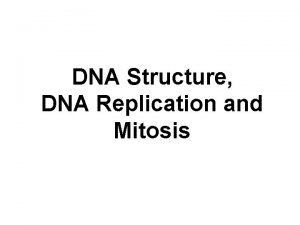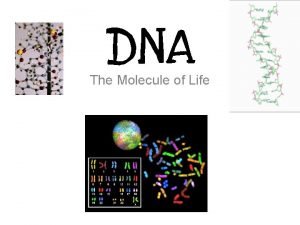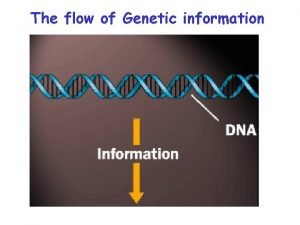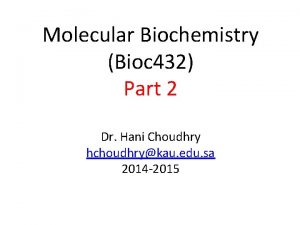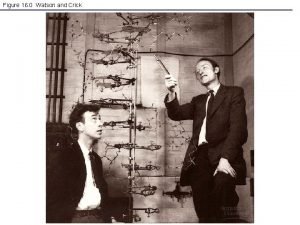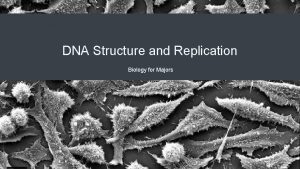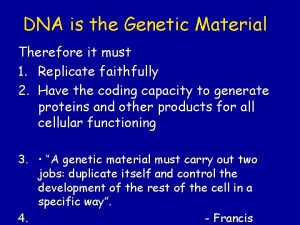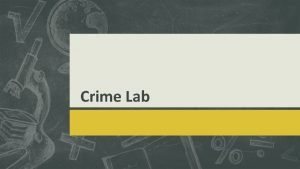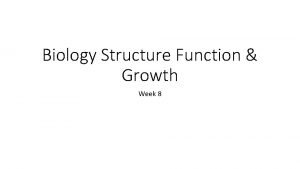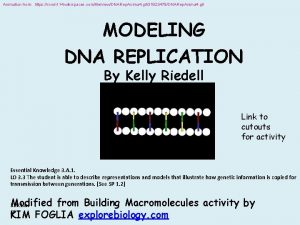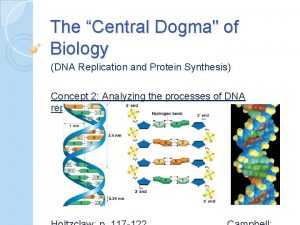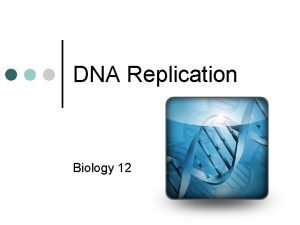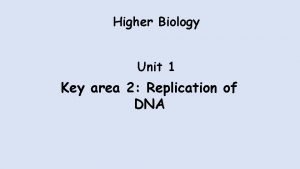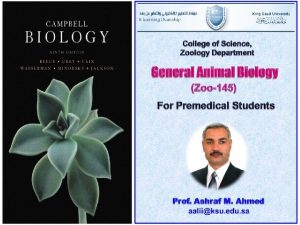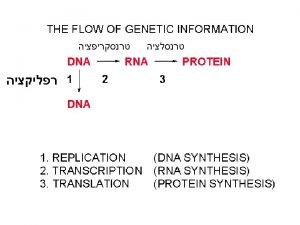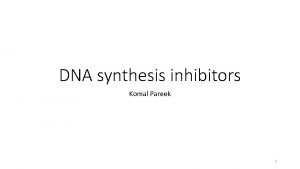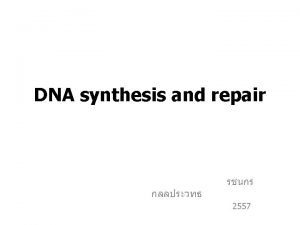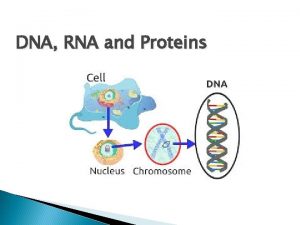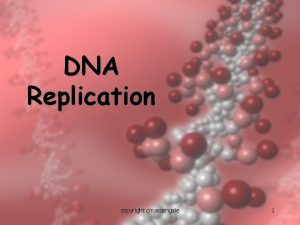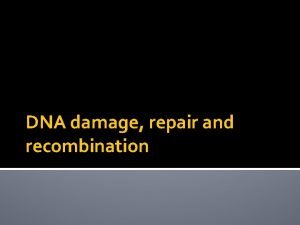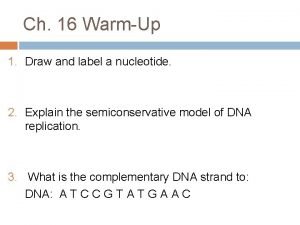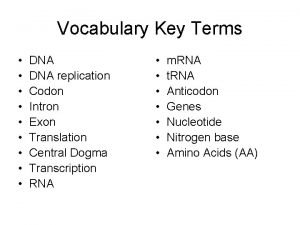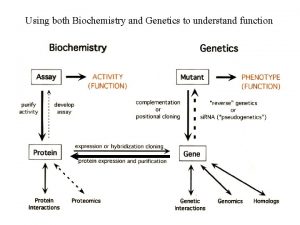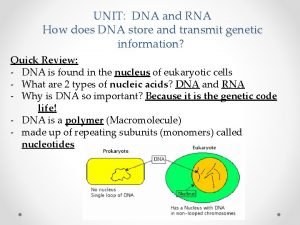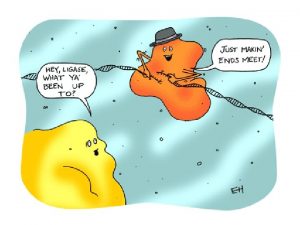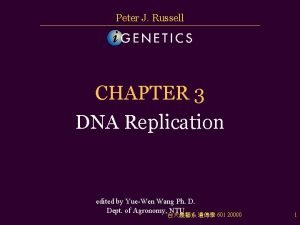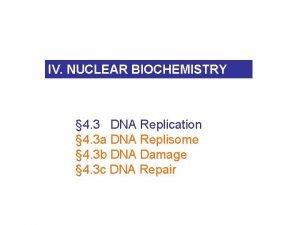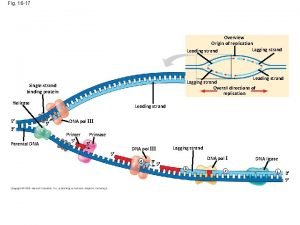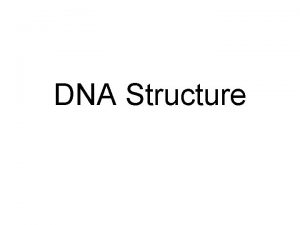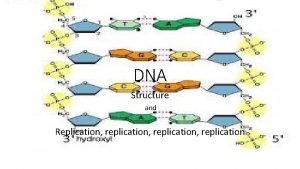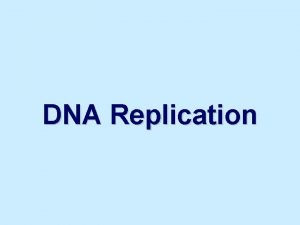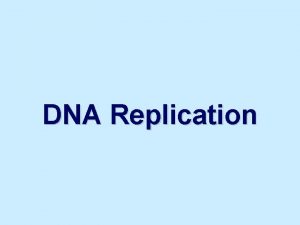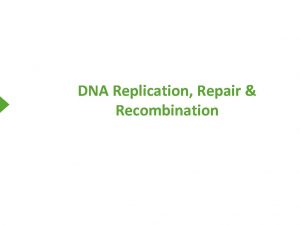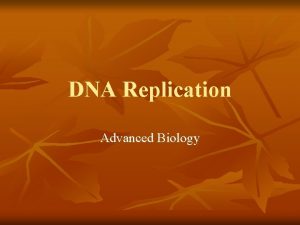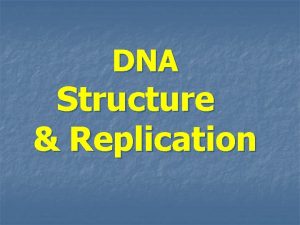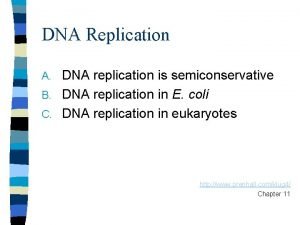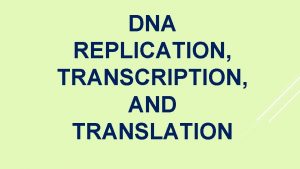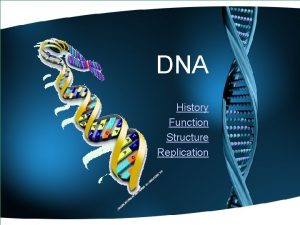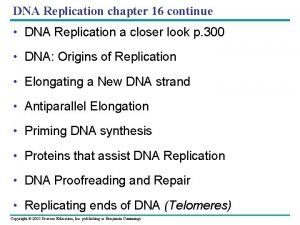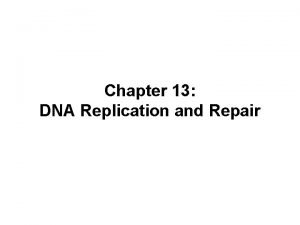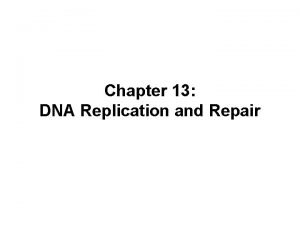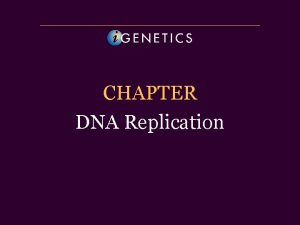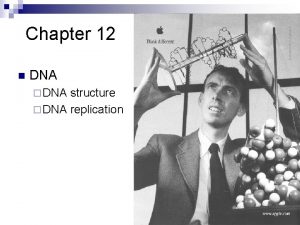DNA DNA History DNA Structure DNA Replication Chapter









































- Slides: 41

-- DNA -DNA History DNA Structure DNA Replication Chapter 12. 1 & 12. 2 AKA Molecular Genetics PART I

Historical Context: Story of DNA 1900's: Scientists knew that chromosomes were responsible for traits being inherited from parents to offspring. However, the key component of the chromosomes that actually contained the genetic information remained a mystery. Chemical analysis of chromosomes told them that the genetic material had to be either proteins or nucleic acids (DNA), but they didn't know which one was responsible for carrying the genetic information.

Griffith's Experiment (1928) In 1928, British bacteriologist Fredrick Griffith experiment What is the genetic material behind inheritance? Griffith injected two different strains of bacteria (Streptococcus pneumoniae) into mice. One strain caused infection (pathogenic/virulent) and one did not. He called the virulent strain the smooth or S strain. He called the non-virulent strain the rough or R strain.

Griffith's Experiment: Must be a “transforming factor”

Oswald Avery (1944) • Isolated the “transforming factor” in the S-strain • Showed it was DNA. • His results were not widely accepted…not conclusive enough. • So scientist kept looking for clearer results; Protein DNA? or

Hershey & Chase Experiment (1952) Alfred Hershey, bacteriologist Martha Chase geneticist Hershey & Chase Experiment Provided conclusive evidence that DNA was in fact the transforming factor.

bacteriophage (a virus that attacks bacteria). Made of the two key components protein and DNA

Hershey and Chase Experiment Hershey and Chase used a technique called radioactive labeling to trace both the protein and the DNA of the bacteriophage after it infected the bacteria (E. coli). Once the virus infected the bacteria with its genetic material, they monitored which radioactive material was inherited by the bacteria. This would identify the genetic material as proteins or DNA. Provided conclusive evidence that DNA was in fact the “transforming factor. ”

Hershey and Chase Experiment (1952) Hypothesis 1: Hypothesis 2:

Hershey and Chase (1952) to clarify. … Another graphic

Chargaff's Rule (1950) In the 1950 s, Erwin Chargaff discovered that in every organism the amount of guanine and cytosine, and the amount of adenine and thymine was nearly equal. This is called Chargaff's rule.

The Double Helix In 1952, Rosalind Franklin used X-rays (crystallography) to photograph DNA. The DNA molecule was in the shape of a twisted ladder known as a double helix. Photo 51

Watson and Crick James Watson and Francis Crick used data from Chargaff and Franklin's photo to build the first accurate model of DNA. Why did its structure matter? Why was everyone so anxious to find out !?

INTERACTIVE HISTORY Summary • • • 1928 – Griffith: “transforming factor” in bacteria 1943 – Avery: “transforming factor” is DNA…inconclusive 1950 – Chargaff: A = T / G = C (AKA Chargaff’s Rule) 1952 - Hershey & Chase: conclusive “transforming factor” is DNA 1952 – Franklin: X-ray crystallography; picture 51 of DNA Double helix • 1953 – Watson & Crick: First accurate model of DNA Double Helix

The Structure and Composition of DNA Scientists were now confident that they had discovered what the genetic material was, but questions remained: What is the structure of DNA? How does DNA communicate information? What they discovered is that DNA is made up of nucleotides. A nucleotide is a sugar molecule, a phosphate molecule, and a nitrogenous base. BUT…How do those nucleotides fit together in DNA?

Chargaff's Rule (1950) In the 1950 s, Erwin Chargaff discovered that in every organism the amount of guanine and cytosine, and the amount of adenine and thymine was nearly equal. This is called Chargaff's rule.

DNA Structure and Composition In the DNA there are four different nitrogenous bases: Cytosine Thymine Adenine Guanine Side note: Uracil (In RNA, replaces Thymine)

The Double Helix In 1951, Rosalind Franklin used X-rays (crystallography) to photograph DNA. The DNA molecule was in the shape of a twisted ladder known as a double helix. Photo 51

The Double Helix

Watson and Crick James Watson and Francis Crick used data from Chargaff and Franklin's photo to build the first accurate model of DNA. Why did its structure matter? Why was everyone so anxious to find out !?

The Structure of DNA is like a twisted ladder made up of alternating strands of deoxyribose (sugar) and phosphate. The rails of the ladder are joined by the bases. (adenine, guanine, cytosine, and thymine)

Complementary Base Pairing Each nitrogen base pairs up with another base in what is known as complementary base pairing. Purine bases pair with pyrimidine bases. • • Adenine and Guanine are called purines. Cytosine and Thymine are called pyrimidines. Adenine always pairs with Thymine. (A T) Guanine always pairs with Cytosine. (G C)

Purines and Pyrimidines

Complementary Base Pairing

Orientation of the DNA Another important feature of the DNA structure is the orientation of the DNA strands. The two strands DNA are referred to as antiparrellel, meaning they run parallel to eachother, but in opposite directions. This orientation is important to understand because it explains how DNA replicates. One end of the DNA strand is referred to as the 5' (fiveprime) end, and the other end is referred to as the 3' (threeprime) end.

DNA Orientation We will discuss the importance of this orientation later

How Does DNA Fit Inside A Cell? Just one strand of DNA in one chromosome can be up to 245 million base pairs long! And remember humans have 46 chromosomes It has been estimated that if all the DNA from just one cell of a human's body was unwound, it would stretch about 6 ft long! That means the DNA in one cell is about 100, 000 times longer than the cell itself! And amazingly, it all fits into the nucleus, which only takes up about 10% of the cell's volume!

How Does DNA Fit Inside A Cell? So how does all that information fit into a cell? DNA coils tightly around small balls of protein called histones. Histones and phosphates from the DNA combine together to form nucleosomes. Nucleosomes combine together to form chromatin fibers, and the chromatin fibers combine together to form the chromosomes.

Chromosomes and Histones *Nucleic Acids are the largest molecules in our bodies

Watson and Crick… • "It has not escaped our notice that the specific pairing we have postulated immediately suggests a possible copying mechanism for the genetic material. "

DNA Synthesis: Semiconservative Replication The way DNA gets replicated is called semiconservative replication. In semiconservative replication, one of the strands always gets copied and the other strand is a copy from the original parent or template strand.

Stages of Replication Semiconservative Replication occurs in three stages: 1. 2. 3. unwinding base pairing Joining 1 During unwinding, an enzyme called DNA helicase unwinds or unzips the DNA double helix. 2 After the strands unwind, another enzyme called DNA polymerase, adds nucleotides to the new strand in complementary base pairs. 3 Joining is more complex on the lagging strand than the leading strand… DNA Ligase joins the Okazaki fragments

Amoeba Sisters – 8 Minutes

Unwinding


Base Pairing =Adding nucleotides • DNA polymerase, adds nucleotides to the growing (new) strand in complementary base pairs. 5’ “DNA Polymerase adds complimentary nucleotides to the 3’ prime end of the growing (new) strand” BUILD A DNA Molecule – Interactives with animations 3’ 5’ 3’ 5’ 3’

Leading vs. Lagging Strand Because the strands are antiparallel, one of the strands can be replicated continuously from one end to the other. This section that is replicated continuously is called the leading strand. The other strand, called the lagging strand, has to be replicated in reverse order in sections of nucleotides. These sections of nucleotides are called Okazaki

Semiconservative Replication “DNA polymerases add nucleotides to the 3' end of a growing strand” DNA polymerases add nucleotides to the 3' end of a growing dna strand

Okazaki fragments are then glued together by Joining. The another enzyme called DNA ligase

Check Your Learning… • ANIMATION… GET IT? • CRASH COURSE: DNA Replication (Short) Whole Video • Animation PLUS Quiz • BUILD A DNA Molecule – Interactives with animations Amoeba Sisters – 8 Minutes

 Bioflix activity dna replication nucleotide pairing
Bioflix activity dna replication nucleotide pairing Replication
Replication Chapter 11 dna and genes
Chapter 11 dna and genes Forms of dna
Forms of dna Multiple choice questions on dna structure and replication
Multiple choice questions on dna structure and replication Nature of dna replication
Nature of dna replication Dna stand for
Dna stand for 3-5 exonuclease vs 5-3 exonuclease
3-5 exonuclease vs 5-3 exonuclease 5 enzymes responsible for dna replication
5 enzymes responsible for dna replication Polyribosomes
Polyribosomes Major enzymes in dna replication
Major enzymes in dna replication Accgtat
Accgtat Dna replication jeopardy
Dna replication jeopardy Dna replication fork
Dna replication fork Missy baker
Missy baker Dna replication foldable
Dna replication foldable Nucleoside triphosphate in dna replication
Nucleoside triphosphate in dna replication Bioflix dna replication
Bioflix dna replication Cell analogy restaurant
Cell analogy restaurant Fork dna
Fork dna Dna replication transcription and translation
Dna replication transcription and translation Replication of dna higher biology
Replication of dna higher biology Why is dna replication considered semiconservative
Why is dna replication considered semiconservative Dna replication pearson
Dna replication pearson Dna replication direction 5' 3'
Dna replication direction 5' 3' Dna replication in bacteria occurs
Dna replication in bacteria occurs Dna replication
Dna replication Dna polymerase proofreading
Dna polymerase proofreading Dna replication comic strip
Dna replication comic strip S phase
S phase Accuracy of dna replication
Accuracy of dna replication Bioflix dna replication
Bioflix dna replication Dna replication
Dna replication Dna synthesis at replication fork
Dna synthesis at replication fork Dna replication phschool
Dna replication phschool Primase
Primase Significance of replication
Significance of replication Replication process
Replication process Nucleotide in dna replication
Nucleotide in dna replication Dna replication fork
Dna replication fork Dna replication
Dna replication Dna replication steps
Dna replication steps





